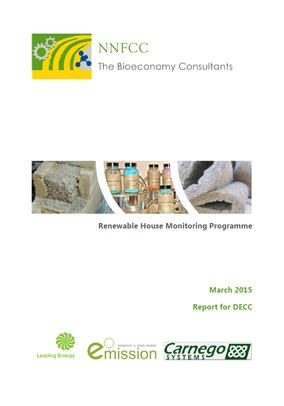 Highlights
Highlights
- NNFCC tested the suitability of renewable materials in the construction sector.
- The Renewable House was made of a timber frame and Hempcrete® walls
- Energy efficiency was tested
- The study aimed to show how practical, affordable, sustainable and scalable these materials can be, offering an alternative for mainstream style homes
- Key lessons were learned to advance future sustainable housing construction and maintenance
Reasons to buy
For housing developers,
investors and public bodies to:
- Explore the opportunities offered by sustainable construction and materials
- See the evidence behind the energy efficiency of sustainable housing
- Learn about the methods for evaluating heating efficiency in housing
- Learn from the real life challenges identified in this project
Number of pages: 19
Accessibility: This item is available to all NNFCC subscribers or through individual purchase
Summary
The UK has recognised that
the environmental impact of construction will have to be tackled if it is to
meet ambitious climate change targets. The industry produces 10 per cent of the
UK’s greenhouse gas emissions, and 50 per cent of all the materials extracted
from the Earth’s crust are used in construction; therefore a fundamental
rethink of building material used and associated technology implementation is
needed. But
can low costs and renewable construction be compatible? This question was
answered via this project; The Renewable House. This unique housing project was
delivered by NNFCC and tested the suitability of renewable materials in the
construction sector.
In 2009-10, the Government invested £6.3m under the Low Carbon Investment Fund (LCIF) to support the construction of 283 low carbon affordable homes; built with a range of innovative renewable materials. The aim was to spur interest in and the development of the renewable construction materials industry, and to engage the affordable housing sector in the low carbon agenda. With support from DECC and funding from the Low Carbon Innovation Fund (LCIF), a further project was commissioned to examine the energy performance of a selection of the renewable housing within the new developments.
The Renewable House possessed a timber frame and Hempcrete® walls and was subjected to co-heating
tests. The study aimed to show how practical, affordable, sustainable and scalable
these materials can be, offering an alternative for mainstream style homes
This report focuses on the results of the co-heating
tests carried out at the NNFCC Renewable House at the Building Research
Establishment (BRE) in Watford and at Long Meadow, Diss. The houses were
constructed from Hempcrete during the 2011/2012 winter. This was done as part
of The Renewable House project. Monitoring
equipment was obtained from Carnego Systems was
installed and used for the test. Electric heaters and thermostats for the
co-heating test were obtained through an HCA grant.
Construction methods of Hemcrete houses can be up to 30% less than traditional brick-block methods. Hemcrete houses can cost less to heat and occupants can reduce their energy consumption costs. However, ensuring lower energy consumption by occupants was dependent on rigorous control of construction, and appropriate use of novel renewable heating using air-source heat pumps and mechanical ventilation systems.
The work and its follow-up stage has provided important
lessons and learning points for the construction industry, leading to the
development of modified construction methods, including offsite hempcrete panel
production to help improve the build performance of such novel materials.
The report concludes that Hemcrete has considerable potential for transforming the UK construction industry. When used correctly, Hemcrete can facilitate substantial carbon emissions savings for the UK.
For detailed information on the tests please purchase the full report, or become an NNFCC subscriber.
You may also be interested in:
Talk to the experts
For business solutions call NNFCC on +44 (0)1904 435 182 or email
enquiries@nnfcc.co.uk